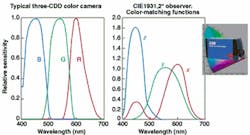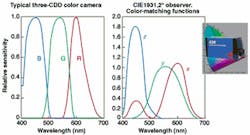Camera measures color precisely
Most machine-vision-system applications use gray-scale cameras to capture images of parts to be inspected. While these cameras have proven efficient, the use of color-based camera systems can be more effective in applications in industries such as printing and textiles, where specific colors must be precisely measured and matched.
To address these sensor requirements, several vendors, such as DVT Corp. (Norcross, GA) and Cognex Corp. (Natick, MA), have announced additions to their smart-camera lines that include models specifically developed for capturing and processing color images. These smart cameras use CCD sensors to capture RGB images that are then processed using color-image-analysis software. In this approach, claim vendors, sensors can discriminate between colored automotive parts, inspect printed products for color matching, and check the colors of fruits and vegetables in food-industry applications. Although RGB image sensors can capture color, the processed colors cannot be described in exact quantitative and numerical terms, making it difficult to qualify precise measurements.
Derived from television technology, RGB cameras obtain color images by separating light into red, green, and blue spectral bands. This spectral separation of light gives rise to errors and ambiguities, since, for any two similar colors, users cannot be sure if the two colors are illuminated differently but have the same color values or whether the colors have different values but are illuminated in the same way.
Standard RGB cameras digitize color by separating the light into RGB spectral bands (top or left). However, this spectral separation differs from the way human beings perceive light (bottom or right). Color sensitivity functions of the 1931 Standard Observer, known as xyz tristimulus values, allow color measurements to be described unambiguously. These functions have allowed Delta to develop a color-image-analyzer camera with the same sensitivity as the human eye.
"While RGB cameras are not good absolute-measurement devices such as the spectrophotometer," says Ali Zadeh, a senior research-and-development engineer at DVT, "they are good relative measurement devices. You can use these cameras to find a good sample and monitor it for any changes, so that when a light blue changes to a dark blue, for example, you will know."
To allow such quantitative measurements to be made precisely, the Commission Internationale de l'Eclairage (CIE; Wien, Austria) developed a color model based on how human beings perceive color. Known as the XYZ Standard Observer, the model uses three stimulus values that provide the basis for an objective description of colors. With known tristimulus values, both the color and the luminance (or brightness) of the object can be described unambiguously.
To obtain these unambiguous color values, Delta Danish Electronics, Light & Acoustics (Lyngby, Denmark; www.delta.dk), has developed an Imaging Color Analyzer Module (ICAM) that is both a digital camera and a color meter. Using an off-the-shelf CCD chip, Delta uses a number of filters in a filter-wheel configuration to obtain the tristimulus color values.
Delta initially measures the monochrome CCD spectral sensitivity. Then, custom filters are developed that map the spectral sensitivity maps to the three tristimulus x-y-z values of the CIE standard observer. Once complete, each filter wheel can produce the exact x, y, or z value that is then digitized by the monochrome camera. A patent has been filed on the optical-system configuration in the camera and for its use in a wider scope.
With a resolution of 1024 x 768 x 8 bits, the camera is capable of capturing one color image in about two seconds. To interface the camera to a PC-based system, the ICAM features a FireWire interface and has been qualified with the IEEE 1394-based Meteor II/1394 PCI-based frame grabber from Matrox Imaging (Dorval, Quebec, Canada). According to Jens Jürgen Jensen, Delta product specialist, the company is already seeing use in print and textile applications, where real-time requirements are not a necessity. At a cost of $25,000 in single quantities, Delta expects to deliver initial systems by year's end.

